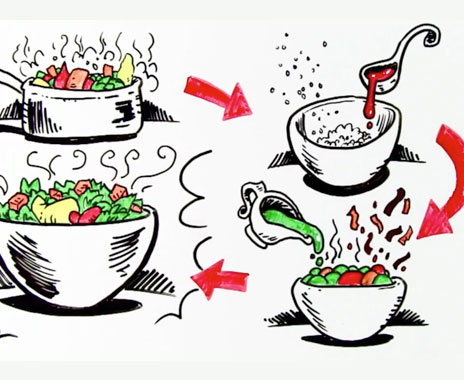Esteemed chef José Andrés, famous for fine-dining restaurants like the Bazaar and Zaytina, entered the limited-service sphere with the Washington, D.C., fast-casual concept Beefsteak, which opened in March.
Don’t be confused by the name, though. What sounds like an homage to red meat is really a play on words; the beefsteaks honored here are of the tomato variety. That clever moniker is the first clue that something unusual is cooking. Instead of following the traditional, meat-centric model that is the backbone of the quick-service industry, Beefsteak’s menu is a love song to vegetables, with dozens of ingredients available for customizable vegetable-and-grain bowls. Animal proteins are available, but they’re accents, not centerpieces.
The menu covers an interesting territory: healthful but hearty. “Real food,” as Jim Biafore, Beefsteak’s director of operations, calls it.
The centerpiece of Beefsteak’s menu—the bowl—is a trend that’s coming into its own, says Darren Tristano, executive vice president of the research and consulting firm Technomic. “Bowls have been around for a while, but they’re starting to evolve and become more complex, more interesting, and more appealing,” he says.
Andrés’ inspiration, Biafore says, were the meals he’d make for his family at home. At Beefsteak, customers follow a build-your-own format, first choosing a grain base—bulgur, quinoa, or rice—then adding a sauce like black bean or spicy tomato. Next, they pile on the veggies, anything from broccoli and corn to kale and asparagus. (Beefsteak recommends four or five vegetables per bowl.) Then come the fresh toppings, like seaweed salad and radishes, and the crunchy toppings, like toasted seaweed and pita chips (Beefsteak suggests three of each).
Finally, customers can add a dressing, like lemon honey or soy ginger. They can also add a hearty protein such as roasted chicken, salt-cured salmon, or poached egg. The base price of a bowl is $7.99, with up-charges for premium ingredients like Mozzarella ($1.99) or salt-cured salmon ($3.99).
“It’s new and unique, but simple,” Biafore says. “There’s nothing added; we’re just assembling the meals for you. You control the entire meal, which is pretty unique.”
There are also several pre-designed bowls, like the Kimchi-wa, made with rice, corn, carrots, cabbage, edamame, bok choy, and roasted garlic yogurt sauce and topped with scallions, toasted sesame seeds, roasted chickpeas, kimchi, and soy-ginger dressing. The flavor profiles are driven by Andrés, who chose all the sauces and toppings.
“They’re really special, complex toppings and unique flavors that are really going to do well to accent the bowl,” Biafore says. “It’s about layers of flavors.”
Beefsteak operates on the “cook less more often” principle, preparing new batches of grains every 20–30 minutes. The vegetables are sourced as locally as possible, from regional farms like Lancaster Organic and Tuscarora Valley, and they’re blanched in salt water for 60–90 seconds and lightly seasoned.
“You don’t need to do anything to a fresh Brussels sprout that was grown carefully and transported well,” Biafore says. “We try to limit what we do with it so it’s as clean as possible.
“People want real food,” he adds. “The consumer is more educated about what they’re eating. The market in general is looking for something in a quicker environment, and it’s got to be healthy; we encompass those things without saying we’re a healthy-food or vegetarian restaurant. We wanted to lead with flavor.”
Eli Rosenberg, vice president of marketing at research firm Food Genius, confirms that vegetables are increasingly finding a place on limited-service restaurant menus.
“In the last three years, we've noticed a lot more emphasis placed on the types of vegetables taking center stage and how restaurateurs market these types of dishes,” he says. “With so much attention from the media on food transparency, food sourcing, and animal welfare, it’s no surprise that Millennials, who eat out more than previous generations, are searching for ways to incorporate healthier, more vegetable-rich options. New restaurants and food entrepreneurs are capitalizing on this trend.”
Likewise, Beefsteak belongs to a new breed of limited-service restaurants overseen by high-profile chefs and restaurateurs, a group that includes Loco’l, the upcoming venture from chefs Roy Choi and Daniel Patterson.
Limited-service restaurants have become so popular among classically trained chefs that the Culinary Institute of America launched a new bachelor’s degree concentration, Intrapreneurship, which focuses on opening a concept within an organization and requires students to run fast-casual pop-up restaurants in the school commons.
“These options, especially for students, offer some really interesting alternatives,” says CIA associate professor of business management Bill Guilfoyle. “New and innovative concepts are going to continue to pop up.” While the big-ticket fine-dining experience still appeals, he adds, “diners really like the idea of not having to get dressed up and going for a lesser price point.”
Plus, from a high-level chef’s point of view, Tristano says, fast casual is an easy way to reach the masses. “Most of [the concepts] from chefs are going to be more complex, [with a] more culinary focus,” he says. “That will differentiate because of the flavor, innovation, and limited offers like local, sustainable options. That’s where the high-level chef is thinking.”
Still, the vegetable-centric niche of the fast-casual category is small, he says, with a more urban, more affluent demographic (or at least a demographic, like Millennials, that’s willing to spend more). “You’re not going to have 500 of these restaurants, so you have to be careful where you open and where your competition is,” Tristano says.
Andrés’ restaurant company, Think Food Group, is exploring Beefsteak expansion.
“We’re like every other restaurant group,” Biafore says. “We want a lot of restaurants. … [Andrés’] mission is to change the world through the power of food, and we all embrace that. For us to reach the masses and feed people healthy, delicious food and promote vegetables without being overly critical about it, this is the vehicle for us to do it.”
So far, he says, the response has been amazing, with many repeat customers. “You can feel good about eating broccoli twice a day,” Biafore says. “And it’s affordable.”





